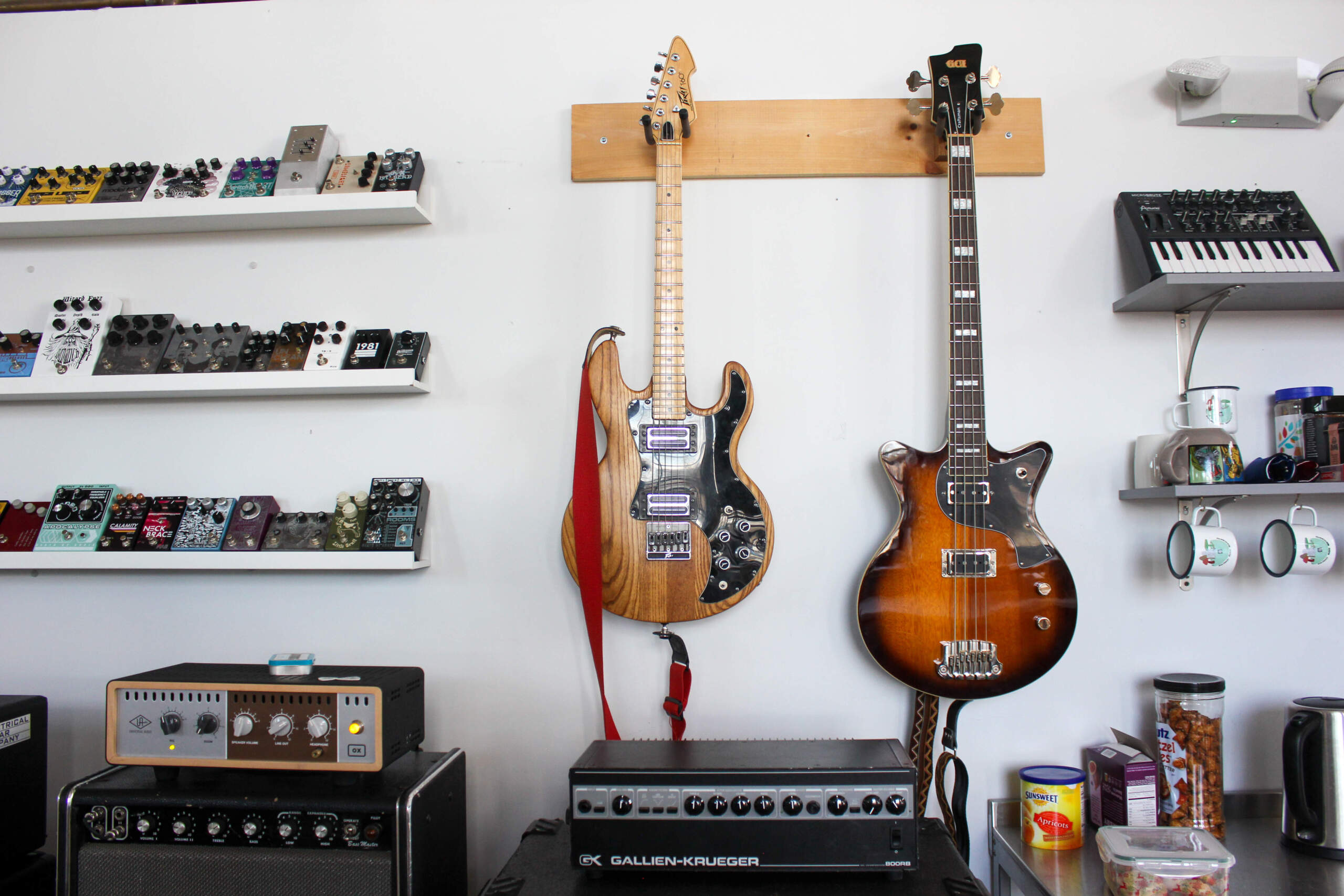 The workshop at Digital Audio Experiments. (Lukas Harnisch for WBUR)
The workshop at Digital Audio Experiments. (Lukas Harnisch for WBUR)
The guitar in John Snyder’s lap is stressed out via a nondescript aluminum field coated in an array of knobs and switches. As Snyder manipulates them, the tone coming from his amp warbles in otherworldly techniques. One minute it appears it’s coming from the a ways finish of a cathedral product of steel, sharp and resonant but additionally stunning. The following, a low growl that virtually sounds human fills Snyder’s sunlit Waltham workshop.
That little field he’s messing with is a prototype Snyder is perfecting for his guitar pedal corporate, Digital Audio Experiments (EAE). He’s reticent to proportion an excessive amount of about it. “You’ve were given to roughly stay other folks on hooks with the brand new stuff,” he says, grinning.
EAE has been ready to carve out relatively a distinct segment within the guitar pedal business, a global the place artistry meets electronics. Hundreds look ahead to the most recent product on-line, and the corporate has formed the sound of influential Boston bands Pile and Kal Marks, and bands additional afield like Los Angeles-based post-hardcore rockers Touché Amoré.
Its footprint is oversized for an organization of 4, which was once running out of a “indisputably unlawful” basement rental in Brighton simply 9 years in the past. “We’re in a perpetual state of backorder,” Snyder admits.
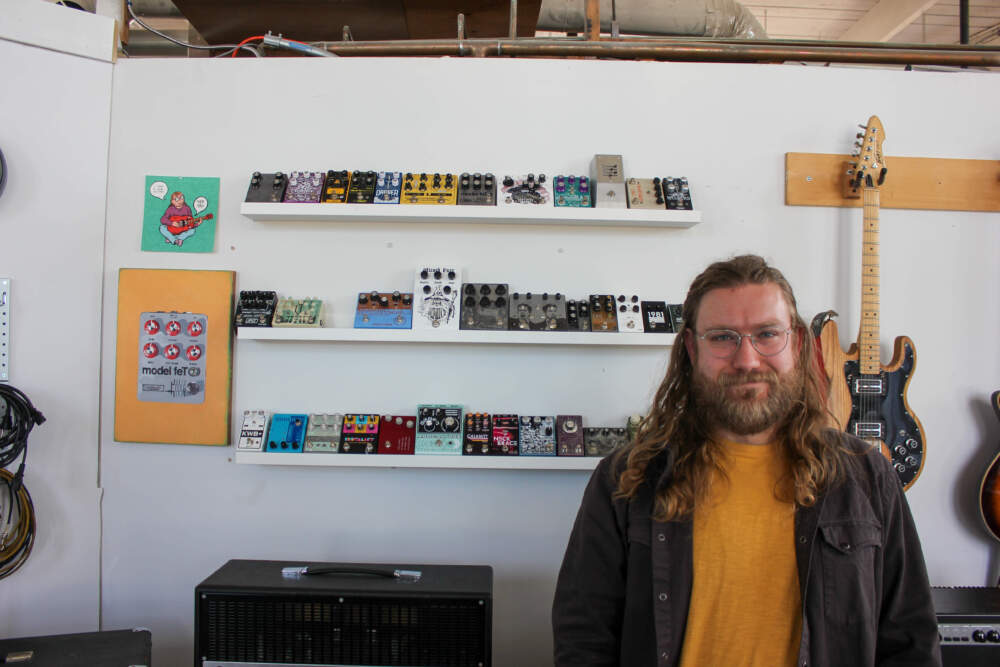 John Snyder, founding father of Digital Audio Experiments. (Lukas Harnisch for WBUR)
John Snyder, founding father of Digital Audio Experiments. (Lukas Harnisch for WBUR)
An established guitarist with a doctorate from Boston College in electric engineering, Snyder began development pedals in 2015 to resolve an issue for the band he performed in. Not one of the distortion-creating devices he may just in finding gave him sufficient keep watch over. So, he took a stab at making his personal. The results of his efforts wasn’t beautiful. The uncovered circuit board was once crowded by way of a multitude of wires, nevertheless it shaped the digital foundation for the Longsword, the pedal that introduced EAE.
“I noticed there have been others in the market on the lookout for the similar sound I used to be,” Snyder says. “It was once simply good fortune.”
Pedals are an integral a part of a guitarist’s arsenal. The use of their toes to cause an array of interconnected circuit packing containers, musicians can harness the forces of distortion, achieve, reverb and extend, dialing in a valid that’s explicit to them.
“They’re like spices,” explains Pile frontman Rick Maguire. “You’ve salt and pepper,” conventional devices that distort or upload echo. “After which there are some like turmeric, the extra experimental ones.” Like the only Maguire not too long ago constructed with Snyder known as Reflect Space, a tool that detunes a guitar tone into an airy warble. “You don’t want a large number of it, it is going some distance.”
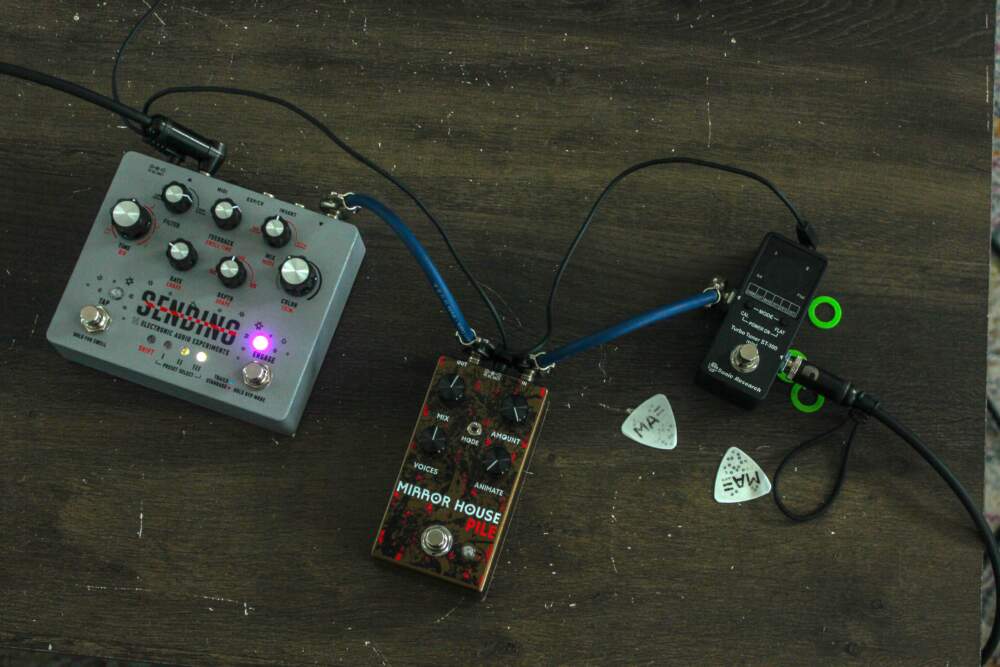 At the left is Sending, a reverb pedal. Within the center, the Reflect Space pedal, a collaboration between Digital Audio Experiments and Pile. (Lukas Harnisch for WBUR)
At the left is Sending, a reverb pedal. Within the center, the Reflect Space pedal, a collaboration between Digital Audio Experiments and Pile. (Lukas Harnisch for WBUR)
There are unending choices to be had to a budding guitarist starting from a $30 heavily produced Behringer to handmade packing containers that opt for tens of hundreds of bucks. It’s a surprisingly aggressive area, however Snyder has been ready to tell apart himself via an in depth partnership with, and figuring out of, musicians.
Touché Amoré guitarists Clayton Stevens and Nick Steinhardt got here to Snyder in 2019, “chasing a valid” as Stevens places it, for the band’s newest album, “Lament.”
Snyder describes Limelight, the pedal he constructed with the band that was once launched in 2020, as “a chimera of vintage circuits.” It’s a really perfect distillation of Snyder’s summary imaginative and prescient to assist musicians “sound extra like themselves.”
Staring at the method was once satisfying for Stevens. “You’ll be able to communicate to [John] in regards to the feeling of one thing, like a musician would, and he can by hook or by crook translate that electronically,” he says. “That’s what makes him actually just right at what he does.”
2020 was once a defining yr for Snyder. Having finished his doctorate, he was once at the process seek, turning down gives for positions within the protection business. “One thing cool will arise sooner or later,” he was hoping. “But it surely didn’t for the reason that economic system was once doing bizarre stuff.”
All the way through faculty, promoting pedals just like the Longsword and some other known as the Halberd was once only a aspect hustle for a broke grad scholar. For some time, production consisted of having a couple of buddies in combination round a tarp-covered folding desk, ordering a pizza, and soldering and assembling during the evening.
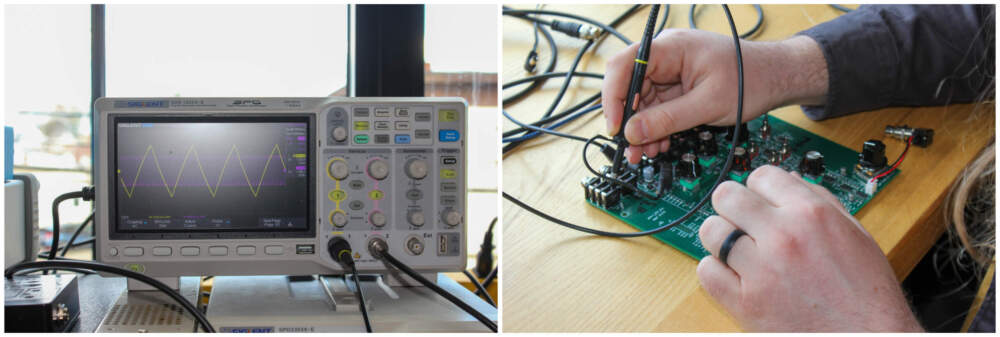 Left, a gadget for examining audio; proper, John Snyder assessments a circuit board. (Lukas Harnisch for WBUR)
Left, a gadget for examining audio; proper, John Snyder assessments a circuit board. (Lukas Harnisch for WBUR)
Call for for pedals was once exploding with such a lot of other folks turning towards indoor leisure pursuits because of the pandemic, and Limelight was once an enormous good fortune. Snyder, suffering to fill orders, discovered, “It is a full-time process, that is how I make my residing.”
There have been the standard demanding situations that include launching a trade. “For 2 years, it was once like, ‘What’s this manner? What sort of account do I open?’” Snyder recollects. “It was once an ordeal by way of hearth.”
Snyder and the small staff he employed have been additionally on the whim of Boston’s extremely aggressive actual property marketplace. Simply over a yr after shifting into their first workshop at 119 Braintree St. in Allston, they have been pressured to relocate when the landlord of the development made up our minds to redevelop it into place of work, lab and retail area.
It was once a painful second that left Snyder upset with the town he spent the ultimate 20 years in. “There’s a cultural drawback right here the place artwork of a undeniable type simply doesn’t have a spot,” he says.
However Snyder has lived in New England all his existence. He couldn’t consider doing trade somewhere else. So when analog synth distributor synthCube introduced EAE an area in its Waltham warehouse, Snyder was once satisfied to just accept. Nonetheless, he turns out frightened in regards to the long run. “How lengthy is the gap going to ultimate?” He asks himself. “There’s an impermanence to the entirety.”
Situated in a nook of the second one flooring, the EAE workshop is stuffed with amplifiers, circuit forums, soldering irons, audio examining gear and the type of baking racks you’d look forward to finding in a kitchen. “The trays are in truth excellent for storing pedals,” Snyder says. Pulling one out, he unearths an array of Longswords in a position to be served.
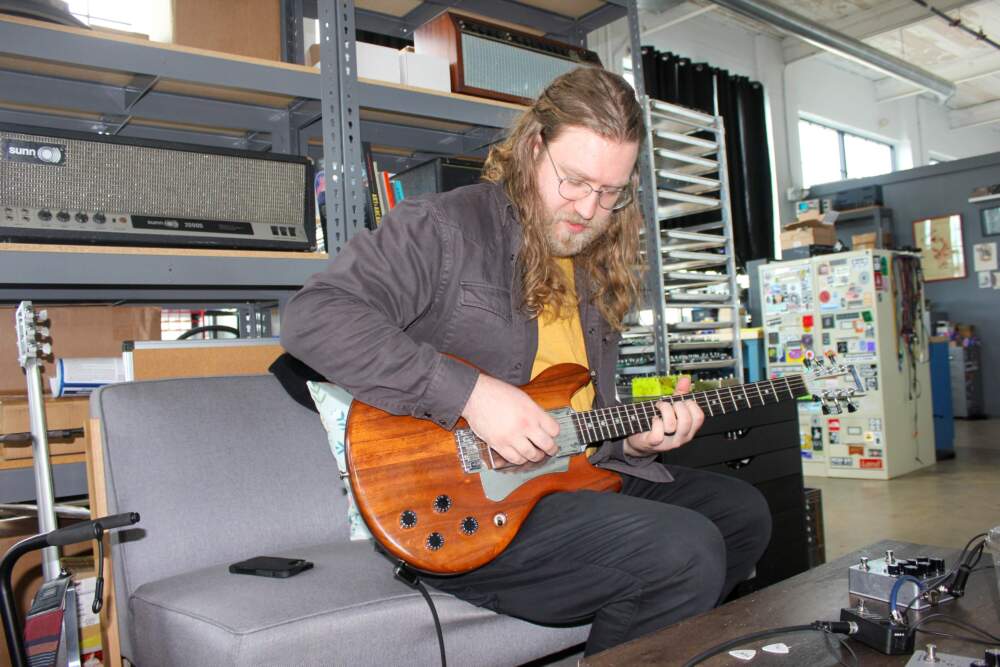 John Snyder performs the guitar and assessments out a pedal. (Lukas Harnisch for WBUR)
John Snyder performs the guitar and assessments out a pedal. (Lukas Harnisch for WBUR)
Along with his doctorate, Snyder turns out overqualified for an business in large part made up of untrained musicians and artists. Pedal circuits haven’t moved a ways from the place they started within the Sixties, and Snyder’s Boston College lab paintings concerned built-in photonics, a box on the intersection of quantum physics and electric engineering. His tale sounds a bit just like the chemistry genius Walter White from “Breaking Dangerous” beginning up a meth lab, however with out the crime.
In reality, Snyder’s research have restricted utility to the sphere, which will really feel extra like an artform than a troublesome science. Numerous what he is aware of about pedals comes from trial and mistake and recommendation from musician buddies. “A few of the ones people can run circles round me,” he admits.
At the present time, a plant has taken over a lot of EAE’s production. So, if there aren’t any fires to place out, Snyder spends a lot of his time being ingenious. He’ll regularly confer with a pedal as a “piece” as though he have been running on a portray. Above his workbench, there’s a printout that reads:
The Ingenious Procedure:
That is superior That is laborious That is s— I’m s— This may well be good enough That is superior
It’s one thing Snyder copied from Rick Perry, the artwork director for Size 20, a “Dungeons & Dragons” recreation display. In the event you hadn’t picked up from the weapon-related pedal names and artwork, Snyder loves D&D. He has performed as a seafaring half-orc pirate in an ongoing marketing campaign along with his spouse and buddies each weekend since 2017.
Perry’s ingenious steps, that have a fittingly New Englander self-flagellation to them, have turn out to be a shorthand within the EAE store. Some days, Snyder’s at a 4 (“I’m s—”). The prototype pedal he’s running on is at a 5 (“This may well be good enough”). And the corporate as an entire?
“That’s at a 5,” he says. “And I’m simply hoping we keep there.”


